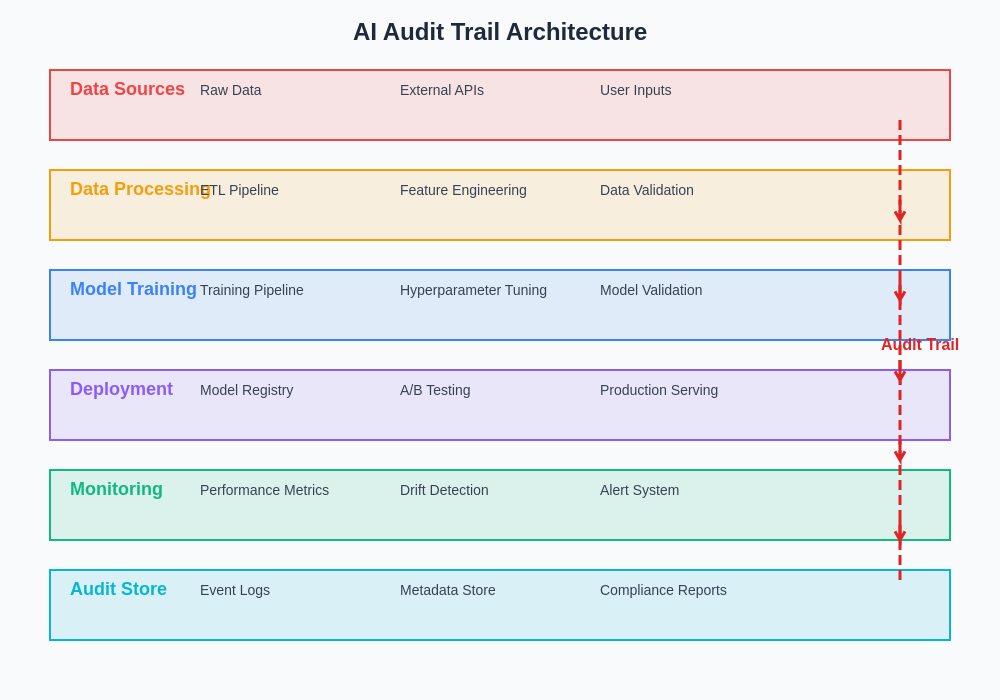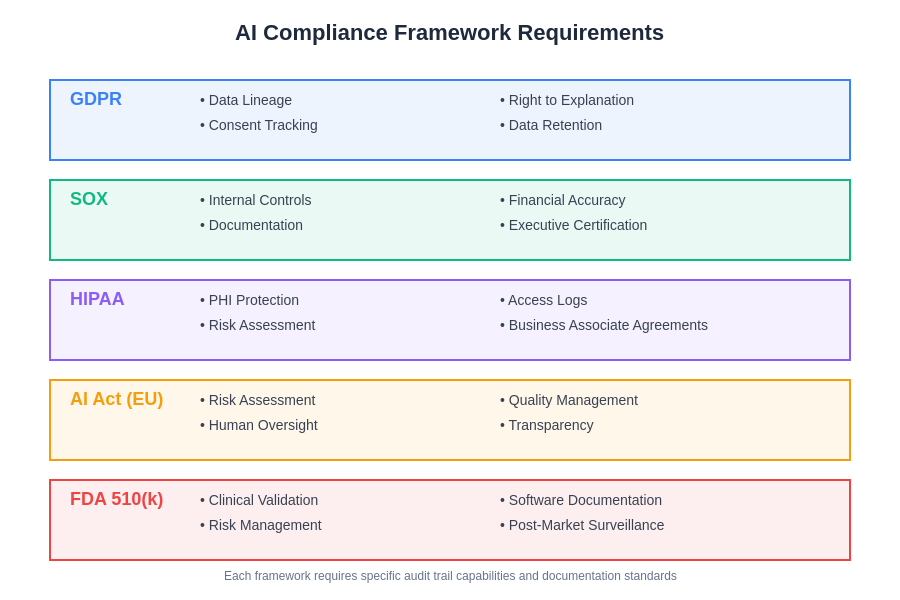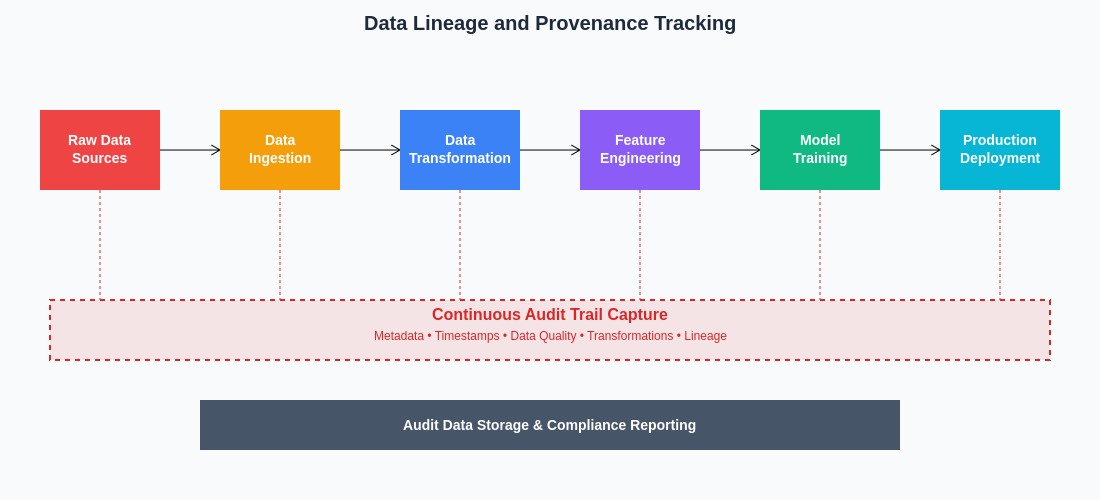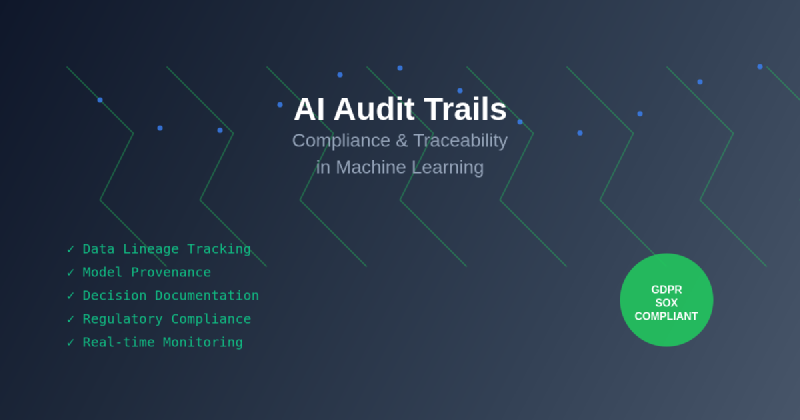The rapid proliferation of artificial intelligence and machine learning systems across industries has ushered in an unprecedented need for comprehensive audit trails that ensure accountability, transparency, and regulatory compliance. As organizations increasingly rely on AI-driven decision-making processes, the establishment of robust traceability mechanisms has become not merely a best practice but a fundamental requirement for maintaining trust, meeting regulatory obligations, and mitigating operational risks. The complexity of modern AI systems, coupled with evolving regulatory landscapes and heightened scrutiny from stakeholders, demands sophisticated approaches to documenting, monitoring, and auditing every aspect of machine learning operations.
Stay updated with the latest AI governance trends to understand how regulatory frameworks and compliance requirements are evolving in response to rapid technological advancement. The intersection of artificial intelligence and regulatory compliance represents one of the most critical challenges facing organizations today, requiring careful balance between innovation velocity and accountability standards.
The Foundation of AI Audit Trails
Comprehensive AI audit trails serve as the backbone of accountable machine learning systems, providing detailed documentation of every decision, process, and transformation that occurs throughout the AI lifecycle. These trails encompass far more than simple logging mechanisms; they represent sophisticated frameworks for capturing, organizing, and preserving evidence of AI system behavior, decision-making processes, and compliance adherence. The foundation of effective audit trails rests upon systematic documentation of data sources, model development processes, training procedures, validation methodologies, deployment configurations, and ongoing monitoring activities.
The establishment of robust audit trail frameworks requires careful consideration of multiple dimensions including temporal consistency, data integrity, access controls, and long-term preservation strategies. Organizations must implement comprehensive logging mechanisms that capture not only the technical aspects of AI operations but also the business context, decision rationale, and human oversight activities that influence system behavior. This holistic approach ensures that audit trails provide meaningful insights into AI system operations while supporting both technical debugging and regulatory compliance requirements.

The comprehensive audit trail architecture demonstrates how different layers of AI systems must be integrated to provide complete traceability from raw data sources through production deployment and ongoing monitoring activities. Each layer contributes essential metadata and documentation that collectively enables full accountability and regulatory compliance.
Regulatory Landscape and Compliance Requirements
The regulatory environment surrounding artificial intelligence continues to evolve rapidly, with jurisdictions worldwide implementing comprehensive frameworks designed to ensure responsible AI deployment and operation. These regulations span multiple domains including data protection, algorithmic accountability, financial services oversight, healthcare compliance, and consumer protection, each imposing specific requirements for documentation, transparency, and auditability. Organizations operating AI systems must navigate complex regulatory matrices that often overlap and sometimes conflict, requiring sophisticated compliance strategies that can adapt to changing requirements while maintaining operational efficiency.
Key regulatory frameworks such as the European Union’s AI Act, various sector-specific regulations in financial services and healthcare, and emerging algorithmic accountability legislation create detailed requirements for AI system documentation and audit trail maintenance. These regulations typically mandate comprehensive records of model training data, algorithmic decision processes, bias testing procedures, performance monitoring activities, and human oversight mechanisms. The global nature of many AI deployments adds additional complexity, as organizations must often comply with multiple regulatory regimes simultaneously while ensuring consistency across jurisdictions.

Different regulatory frameworks impose varying requirements for AI audit trails and documentation standards. Organizations must carefully map their audit trail capabilities against applicable regulatory requirements to ensure comprehensive compliance across all relevant jurisdictions and industry sectors.
Enhance your AI compliance strategy with advanced tools like Claude that can assist in documentation generation, regulatory analysis, and compliance monitoring activities. The integration of AI-powered tools into compliance workflows can significantly improve the accuracy and efficiency of audit trail maintenance while reducing the burden on human compliance teams.
Data Lineage and Provenance Tracking
Data lineage represents one of the most critical components of AI audit trails, providing comprehensive documentation of data flow, transformation, and usage throughout machine learning pipelines. Effective data lineage tracking captures the complete journey of information from original sources through various processing stages, feature engineering procedures, model training phases, and ultimate utilization in production systems. This end-to-end visibility enables organizations to understand exactly how data influences AI system behavior, identify potential sources of bias or error, and demonstrate compliance with data governance requirements.
The implementation of robust data provenance tracking requires sophisticated technical infrastructure capable of automatically capturing metadata about data sources, transformation logic, quality metrics, and access patterns. Modern data lineage systems must handle complex scenarios including data fusion from multiple sources, dynamic feature engineering, real-time streaming updates, and distributed processing environments. The challenge extends beyond mere technical implementation to encompass organizational processes, data stewardship practices, and cross-functional collaboration mechanisms that ensure accurate and complete lineage documentation.

The data lineage flow illustrates the comprehensive tracking required throughout the AI pipeline, from raw data sources through feature engineering to production deployment. Continuous audit trail capture ensures that every transformation and decision point is documented for compliance and debugging purposes.
Model Development and Training Documentation
Comprehensive documentation of model development and training processes forms a cornerstone of effective AI audit trails, providing detailed records of algorithmic choices, hyperparameter selections, training procedures, and validation methodologies. This documentation must capture not only the technical aspects of model development but also the business context, stakeholder requirements, and decision-making processes that guide development choices. The complexity of modern machine learning workflows, including automated hyperparameter tuning, ensemble methods, and transfer learning approaches, demands sophisticated documentation strategies that can handle dynamic and iterative development processes.
Effective model development documentation encompasses multiple layers including conceptual model architecture, detailed implementation specifications, training data characteristics, evaluation metrics and results, validation procedures, and performance benchmarking activities. Organizations must also document the rationale behind key decisions such as algorithm selection, feature engineering choices, training data filtering criteria, and model architecture modifications. This comprehensive approach ensures that model development decisions can be understood, reproduced, and validated by independent parties, supporting both technical maintenance and regulatory compliance requirements.
Algorithmic Decision Tracking and Explainability
The tracking of algorithmic decisions represents a critical component of AI audit trails, particularly for systems that directly impact individuals or make autonomous decisions with significant consequences. Effective decision tracking must capture not only the final outputs of AI systems but also the intermediate reasoning processes, confidence levels, contributing factors, and alternative options considered during decision-making. This granular level of documentation enables organizations to explain AI system behavior to stakeholders, identify potential biases or errors, and demonstrate fair and transparent decision-making processes.
Modern explainable AI techniques provide powerful tools for generating decision explanations and audit documentation, but their effective implementation requires careful integration with broader audit trail frameworks. Organizations must balance the need for comprehensive decision documentation with practical constraints including performance impact, storage requirements, and computational overhead. The challenge is further complicated by the need to provide explanations at different levels of technical detail depending on the audience, from technical practitioners to business stakeholders to regulatory authorities.
Leverage advanced AI research capabilities with Perplexity to stay informed about emerging explainability techniques and regulatory requirements that may impact your audit trail strategies. The rapid evolution of explainable AI methodologies creates ongoing opportunities to enhance decision tracking and documentation capabilities.
Real-Time Monitoring and Anomaly Detection
Real-time monitoring capabilities represent essential components of comprehensive AI audit trails, providing continuous visibility into system performance, behavior patterns, and potential anomalies that may indicate problems or compliance violations. Effective monitoring frameworks must track multiple dimensions of AI system operation including prediction accuracy, data quality metrics, feature distribution shifts, computational performance, and user interaction patterns. The integration of real-time monitoring with audit trail systems ensures that unusual events or performance degradations are automatically documented and can be correlated with other system activities for comprehensive root cause analysis.
Advanced monitoring systems employ sophisticated anomaly detection algorithms to identify patterns that may indicate bias introduction, data quality problems, model drift, security threats, or other issues that require immediate attention. These systems must be carefully calibrated to minimize false positives while ensuring that genuine problems are detected promptly. The challenge extends beyond technical monitoring to encompass organizational processes for responding to alerts, investigating anomalies, and updating audit documentation based on monitoring findings.
Access Controls and Security Considerations
The implementation of robust access controls represents a critical aspect of AI audit trail security, ensuring that sensitive information is protected while maintaining appropriate transparency for legitimate stakeholders. Effective access control frameworks must balance multiple competing requirements including the need for comprehensive documentation, protection of proprietary information, compliance with privacy regulations, and support for collaborative development and maintenance activities. Organizations must implement sophisticated role-based access controls that provide appropriate levels of visibility to different stakeholder groups while maintaining comprehensive audit logs of who accessed what information when.
Security considerations for AI audit trails extend beyond traditional access controls to encompass data integrity verification, tamper detection, and long-term preservation of critical documentation. The distributed nature of many AI systems creates additional security challenges, as audit trail components may be stored across multiple systems, cloud providers, and geographical locations. Organizations must implement comprehensive security architectures that protect audit trail integrity while ensuring availability and accessibility for legitimate audit and compliance activities.
Integration with DevOps and MLOps Pipelines
The seamless integration of audit trail capabilities with modern DevOps and MLOps pipelines represents a critical success factor for maintaining comprehensive documentation without impeding development velocity or operational efficiency. Effective integration strategies embed audit trail generation into existing workflows, automatically capturing relevant documentation and metadata as natural byproducts of development, testing, and deployment activities. This approach minimizes the burden on development teams while ensuring that audit trail completeness is maintained throughout rapid iteration cycles and continuous deployment processes.
Modern MLOps platforms provide sophisticated capabilities for integrating audit trail generation with automated testing, model validation, deployment pipelines, and production monitoring systems. Organizations must carefully design these integrations to ensure that audit trail requirements are satisfied without creating bottlenecks or introducing significant overhead into development workflows. The challenge extends beyond technical integration to encompass cultural and process changes that embed accountability and documentation practices into team workflows and organizational culture.
Storage and Retention Strategies
Effective storage and retention strategies for AI audit trails must address multiple competing requirements including long-term accessibility, cost optimization, regulatory compliance, and technical scalability. The volume of data generated by comprehensive audit trails can be substantial, particularly for high-frequency AI systems or organizations operating multiple machine learning applications. Organizations must implement intelligent storage architectures that balance immediate accessibility requirements with long-term preservation needs while managing costs and maintaining performance.
Modern storage strategies often employ tiered approaches that automatically migrate audit trail data through different storage tiers based on age, access patterns, and regulatory requirements. Hot storage provides immediate access to recent audit data for ongoing monitoring and investigation activities, while warm and cold storage tiers offer cost-effective long-term retention for historical data that may be needed for compliance or forensic purposes. Organizations must also consider geographic distribution requirements, backup and disaster recovery strategies, and data sovereignty regulations that may impact storage architecture decisions.
Compliance Reporting and Attestation
The generation of comprehensive compliance reports and attestations based on audit trail data represents a critical capability for organizations operating AI systems in regulated environments. Effective reporting frameworks must automatically aggregate and analyze audit trail data to produce standardized reports that demonstrate compliance with specific regulatory requirements while providing evidence of proper governance and oversight practices. These reports must be generated reliably and consistently, with appropriate controls to ensure accuracy and completeness of the underlying data.
Modern compliance reporting systems employ sophisticated analytics and visualization capabilities to transform raw audit trail data into meaningful insights for different stakeholder audiences including internal management, regulatory authorities, external auditors, and board oversight committees. The challenge lies in creating flexible reporting frameworks that can adapt to evolving regulatory requirements while maintaining consistency and reliability across different reporting periods and jurisdictions. Organizations must also implement appropriate review and attestation processes to ensure that compliance reports accurately reflect the actual state of AI system operations and governance practices.
Emerging Technologies and Future Considerations
The landscape of AI audit trails continues to evolve rapidly with the introduction of new technologies and methodologies that promise to enhance traceability, transparency, and compliance capabilities. Blockchain-based audit trail systems offer immutable records of AI system activities, while advanced analytics and visualization tools provide new ways to explore and understand complex audit data. Federated learning and edge computing deployments create new challenges for maintaining comprehensive audit trails across distributed environments, requiring innovative approaches to data collection and aggregation.
Artificial intelligence itself is increasingly being applied to enhance audit trail capabilities through automated anomaly detection, pattern recognition, and compliance monitoring systems. These meta-AI applications can identify potential issues, generate alerts, and even suggest corrective actions based on comprehensive analysis of audit trail data. However, the use of AI to monitor AI systems introduces additional complexity and potential recursive challenges that must be carefully managed to maintain system integrity and reliability.
The integration of AI audit trails with broader enterprise risk management and governance frameworks represents an emerging area of significant importance. Organizations are beginning to recognize that AI audit trails provide valuable insights not only for regulatory compliance but also for business intelligence, operational optimization, and strategic decision-making. This broader perspective on audit trail value is driving investments in more sophisticated analytics capabilities and integration with enterprise data platforms.
Building Organizational Capabilities and Culture
The successful implementation of comprehensive AI audit trails requires more than technical solutions; it demands the development of organizational capabilities, processes, and cultural practices that prioritize accountability, transparency, and continuous improvement. Organizations must invest in training programs that help technical teams understand audit requirements and develop skills for implementing effective documentation practices. This cultural transformation often requires significant change management efforts to overcome resistance and establish new workflows that integrate audit trail generation into daily activities.
Effective AI governance programs establish clear roles and responsibilities for audit trail maintenance, including data stewardship, compliance monitoring, and documentation quality assurance activities. Cross-functional teams that include technical practitioners, compliance professionals, legal experts, and business stakeholders must collaborate effectively to ensure that audit trail requirements are understood, implemented, and maintained consistently across the organization. The development of these collaborative capabilities represents a critical investment in long-term AI governance success.
Disclaimer
This article is for informational purposes only and does not constitute legal, regulatory, or professional advice. The views expressed are based on current understanding of AI governance and compliance requirements, which continue to evolve rapidly. Organizations should consult with qualified legal and compliance professionals to understand their specific regulatory obligations and develop appropriate audit trail strategies. The effectiveness of audit trail implementations may vary depending on specific regulatory requirements, technical environments, and organizational contexts.
